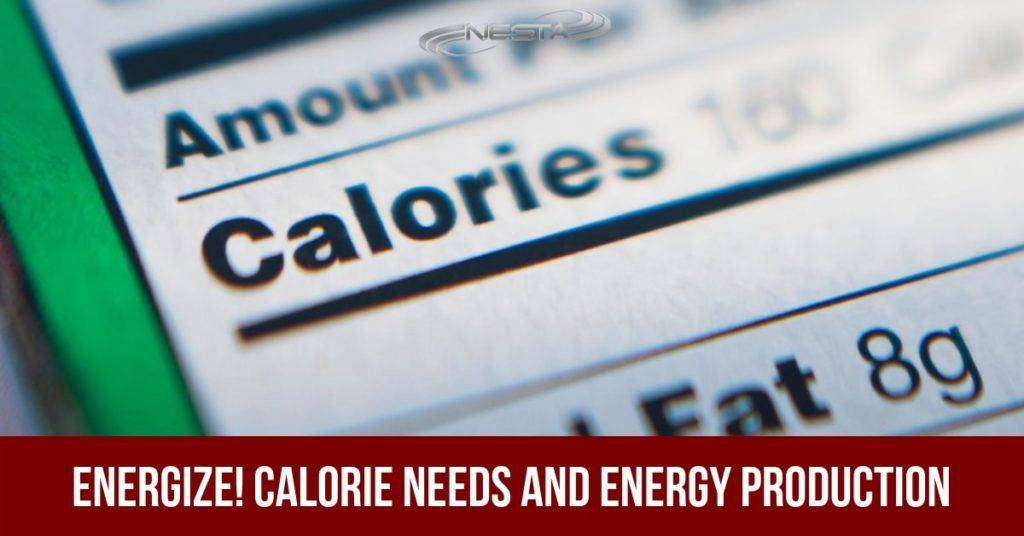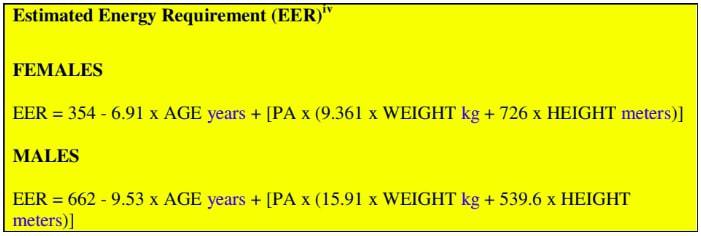What Is A Calorie?
Technically, a calorie is a measure of heat or unit of energy, but to the human body, calories keep everything going. Every bodily function from heartbeats to muscle contractions requires calories. The body needs a certain amount of calories per day from food to operate. Through the processes of digestion, absorption and various metabolic pathways, the body converts calories from food into usable energy to perform. Some of this energy is used immediately, and some are reserved for later use. Calories from food bring along other important nutrients.
Six Classes of Essential Nutrients
- Carbohydrate
- Protein
- Fat
- Vitamins
- Minerals
- Water
The major nutrients to consider for calorie intake and energy production are carbohydrates, protein and fat, also referred to as the “macronutrients.” In addition to the macronutrients, water, vitamins, and minerals make up what is commonly referred to as the “six classes of essential nutrients” (see Table 2.1). Though only the three macronutrients provide calories, all six nutrient groups are required in various amounts for a healthy body. These six groups are classified as “essential” because they must be obtained from food, the body does not have the capability to produce them on its own. Each of these nutrient groups has specific requirements for daily intake. In addition to quantity, it is also important that these nutrients are consumed at the proper times throughout the athlete’s day.
Nutrient Density
It is important for athletes to meet their calorie needs. The quality of those calories is equally important. The concept of nutrient density describes the amounts of nutrients present in food for a given number of calories. The more nutrient-dense food is, the more nutrients it contains. For example, compare 100 calories of soda to 100 calories of milk. In 100 calories of soda, you get sugar (carbohydrate). There are also some carbs in 100 calories of milk, but you will also receive calcium, protein and vitamins A and D. The milk is more nutrient dense.
Nutrient dense foods give you more “bang for your calorie buck,” and overall, a healthy diet should consist of a majority of nutrient-dense foods.
Determining Calorie Needs
It is not always easy for athletes to meet their daily calorie needs. Intense training schedules can often put athletes at risk for undernutrition, which can lead to fatigue and injury. Unfortunately, many athletes do fall short of meeting their needs and even if the athlete is lucky enough to avoid injury this type of continuous calorie deficit will most likely lead to decreased performance. In addition to compromised ability, athletes that do not meet calorie needs are also at risk for undesired weight loss, which may be accompanied, by a loss of lean body mass. To complicate the issue, despite having very healthy body composition, many athletes express a desire to lose weight or are competing in a weight based sport, like wrestling, crew or gymnastics, for example.
Daily calorie needs vary significantly from person to person. To accurately calculate calorie needs you must consider numerous factors including gender, height, weight, age and activity level. If any of these variables change, calorie intake should be adjusted accordingly. To accommodate an active athlete, changes may also need to be made at various times throughout the year during different types of training. For example, a preseason athlete participating in 2-a-day training sessions will need more calories during that time to fuel extra workouts.
There are many reliable online tools to calculate energy needs (see Online Resources). To get an idea of the inputs required to calculate energy needs look at the equation for the Estimated Energy Requirement (EER) from the Institute of Medicine.
Energy Production

Aerobic Metabolism: Energy production that occurs in the presence of oxygen; large amounts of ATP are produced.
Anaerobic Metabolism: Energy production that occurs in the absence of oxygen; lactic acid is a byproduct.
Intake and Expenditure
The other piece to the calorie puzzle involves how they are continuously utilized or burned. To successfully assess the nutritional status of an athlete, you must weigh the amount of energy they are taking in (from food) versus the amount of energy they are expending (from all activity).
Energy Balance
When caloric intake exceeds expenditure – known as positive energy balance – it creates a condition that can lead to weight gain. Conversely, when calorie expenditure exceeds intake – negative energy balance occurs – which can lead to weight loss. Either state of energy balance can have positive or negative effects on performance depending on the situation. Individual energy expenditure is very difficult to calculate accurately. Heart-rate monitors and other equipment can be helpful (this will be discussed further in section 8).
Recommendations for Athletes
When it comes to an athletic population, it appears that instead of struggling to reduce calorie intake (like many inactive individuals) it is more difficult to satisfy energy needs. There are many steps that athletes can take to make sure they are eating enough of the right kinds of calories (see Table 2.2).
Tips for Meeting Calorie Needs
- Calculate daily calorie needs
- Eat frequently throughout the day
- Carry quality snacks with you at all times
- Choose energy-dense foods








